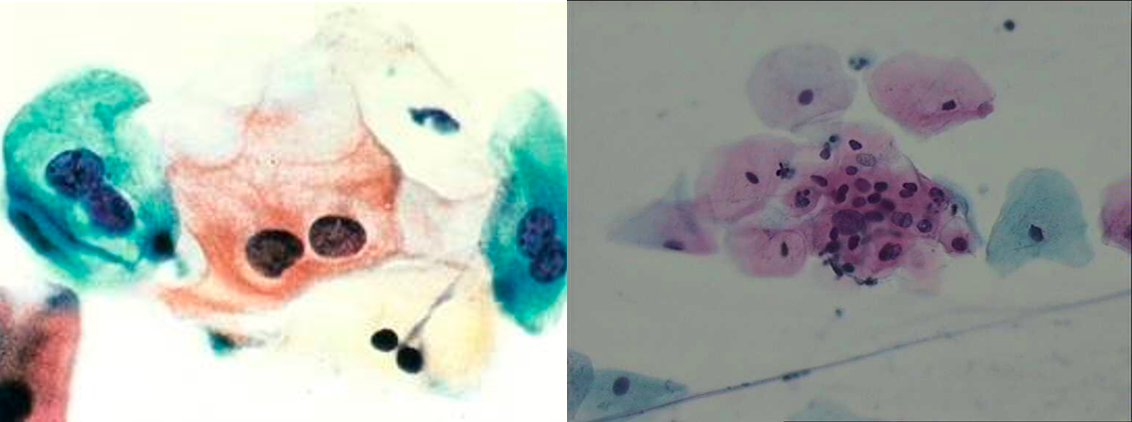The Dysplasia counseling is a specialised appointment for diseases of the vulva, vagina, and cervix uteri (uterine cervix). In the Dysplasia Clinic Zurich, diagnostics such as colposcopy and cytology are conducted, and if necessary, therapy is provided directly in the clinic.
In the Dysplasia Clinic, we investigate abnormal smears and further assess changes in the vulva and vagina, providing appropriate therapy. We also offer consultations for referring physicians and second opinions for patients, addressing questions such as:
What should be done with an abnormal smear during pregnancy?
Should surgery be performed before fertility treatment, or can it be delayed?
Can an intrauterine device (IUD) be inserted?
Is surgery (LLETZ loop excision or knife cone biopsy) necessary?
HPV Infections: Human Papilloma Virus
HPV-Infektionen: Human Papilloma Viren
What does an HPV infection mean?
Approximately 80% of women will have evidence of an HPV infection at some point in their lives. It most commonly occurs between the ages of 20 and 30. In over 80% of cases, the infection clears on its own. Certain HPV viruses are involved in the development of cervical cancer. Most HPV infections occur without symptoms and have no consequences for women. Women are often frightened by the presence of a carcinogenic virus and unnecessary operations are sometimes performed due to the detection of HPV. Having a carcinogenic virus does not lead to significant changes in the cervix; however, in combination with various cofactors such as smoking and immunodeficiency, it plays a role in the development of precancerous lesions and ultimately cervical cancer. This occurs only with persistence over several years when the body cannot eliminate the viruses.
HPV Diagnosis / HPV Screening
Certain types of Human Papillomavirus (HPV) are primarily responsible for the development of precursors to cervical cancer. These are referred to as "High Risk" types, with the most common being types 16 and 18. Other types include 26-31,33-35-39-45-51-52-56-58-59-68. Types 53-66-69-70-73-82 are considered likely "High Risk." Different types pose varying risks of developing precancerous lesions, typically only in cases of persistent infection when the body cannot eliminate the viruses. "Low Risk" types, including 6-11-40-42-43-44-54-61, rarely lead to precancerous lesions. The marked types are covered by the nonavalent vaccine.
Therefore, HPV screening instead of Pap smear does not make sense because the goal is not to detect the HPV infection, which can be considered like a common cold of the cervix, but to identify cell changes caused by the HPV virus. It is more expensive and paradoxical to perform a Pap smear with knowledge of the HPV status than without.
However, HPV lesions in the genital area caused by types 6 and 11 can be benign, known as condylomas or genital warts. These are not dangerous but can be extremely bothersome, requiring patience from both the patient and treating physicians.
HPV Vaccination:
The HPV vaccine targets the cause of cell changes that can lead to cancer. It is not a vaccine against cancer but against the viruses that, in rare cases, can lead to cancer if no preventive measures are taken. In Switzerland, the vaccine was introduced in 2008, initially covering only 2 High Risk viruses, namely types 16 and 18. However, many other High Risk viruses are responsible for cell changes. Since the vaccine does not provide protection against other types, preventive measures must be followed as if no vaccination has taken place. The vaccination should be administered to girls before their first sexual activity. In Switzerland, vaccination is currently covered by health insurance up to the age of 26, under cantonal control.
Since 2019, the nonavalent vaccine has been available, covering not only 2 but 7 High Risk viruses and 2 Low Risk types (6 and 11). This is a significant advancement, and it is hoped that this will lead to a reduction in severe precancerous lesions. Since the vaccine also covers low-risk types 6 and 11 responsible for condylomas, it is a huge advantage for young women. HPV viruses not only cause changes in the cervix but are also involved in other cancers such as anal, vulvar, or oropharyngeal cancers. Due to low vaccination rates in Switzerland, the benefit of herd immunity is not realized, a situation also observed in countries like Germany.
Detection of HPV Infection
Various methods are available to determine HPV infection, with the most common being the PCR method or the Hybrid Capture method. There are also tests that detect mRNA, indicating cell infection. This detection occurs directly on the cells. There is no blood test to determine if an infection is present or has occurred; only the vaccine manufacturers perform such tests.
Cytologically, HPV infections show typical changes such as koilocytes (left image) and dyskeratocytes (right image).
